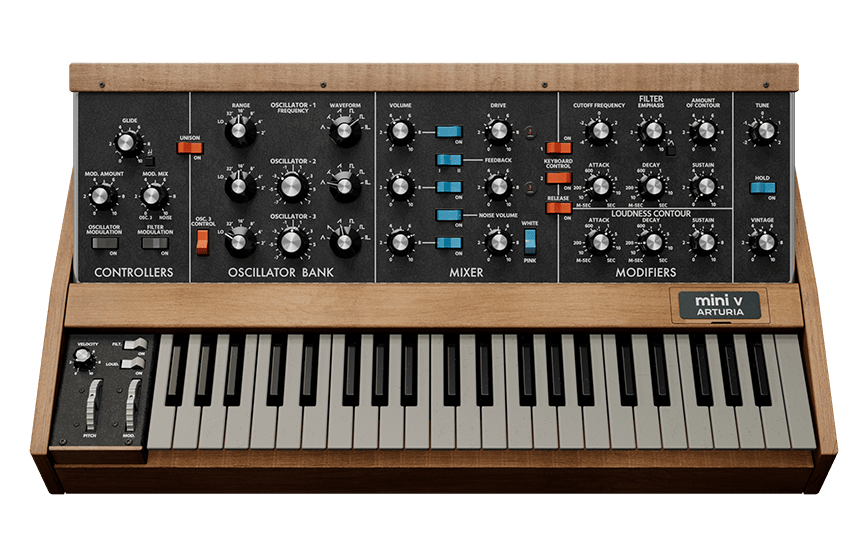Arturia Minimoog V Crack Mac
Dec 10, 2013 - arturia minimoog V serial mac - Arturia Minimoog V (artmmv2) for PC question.
This is the one that switched on the synthesizer in popular music. Huge, massive, powerful, flexible all of this recreated in great detail for you. Arturia, in partnership with Bob Moog, has made a faithful reproduction of one of the most famous series of synthesizers: Moog Modular. Whether recreating the abstract tonal qualities of the classic electronic soundtracks, or pushing forward the sonic boundaries of today, the Moog Modular V is the synthesizer of choice for sound exploration, anywhere, anytime.
When someone mentions vintage synthesizers, what model immediately springs to your mind? If your first thought is “Minimoog,” you're not alone. The Minimoog Model D was the most popular synth from its introduction in 1971 until it ceased being produced more than a decade later. Since then, its sound has remained part of modern music's electronic vocabulary. A couple of years ago, a new Minimoog stepped up to the plate: the Moog Voyager.
The Moog Voyager is the Lamborghini of monosynths — an object of widespread desire, worth every penny, but perhaps too costly for the common person. Fortunately, music software developers provide musicians with virtual versions of instruments that they could never afford in the real world. When soft synths began to gain popularity, Minimoog was one of the first synths that everyone wanted to see emulated. Doing it right, though, was easier said than done. Virtual Minimoog clones appeared in the guise of Creamware's Minimax and Korg's OASYS PCI Minisynth, but neither of those ran without their respective DSP cards. Arturia, a company that made a name for itself with Moog Modular V and CS-80V, is the first company to produce an accurately detailed Minimoog emulation that runs native, without the need for additional hardware.
Minimoog V operates as a standalone program that supports ASIO, DirectSound, and CoreAudio drivers; it also runs as a plug-in for VST, Audio Units (AU), DirectX, RTAS, HTDM, and MAS (Mac OS 9 only) hosts. THE PLAYING FIELD For this review, I used Minimoog V's AU version in Emagic Logic and in Digital Performer, the VST version in Cubase SX, and the standalone version using CoreAudio. My computer is a dual-processor Power Mac G4/1 GHz with 1.5 GB of RAM running Mac OS × 10.3.4. My audio hardware is a MOTU 2408mkII with a PCI-424 card.
Installation was a snap, without the copy-protection issues that plague most music software. I inserted the disc, opened the installer, typed in my name and serial number, opened the standalone version, specified my audio and MIDI ports, and I was up and running in seconds.
Keep the disc in a safe place after installation, because you'll need it for installing any updates or adding any new presets you might download from Arturia's Web site. The manual is in English, French, and Japanese. The English portion is 75 pages long, but about half is devoted to explaining the history and physics of analog synthesis. Although the remainder explains how to install and use the program, you should have no trouble grasping most of it on your own. VIRTUAL WOOD PANELING Like its namesake, the Minimoog V features three oscillators, a noise generator, a 24 dB-per-octave lowpass filter, and two 3-stage envelopes (the decay and release times are identical unless you flip a switch that provides instant release).
In addition to the traditional Minimoog's two modulation sources (oscillator 3 and noise), the software furnishes a modulation matrix (more about that later) and an LFO that syncs to MIDI tempo. Like the original, the virtual synth can process external audio signals. The user interface is laid out exactly like the Model D's front panel, with the Controller, Oscillator Bank, Mixer, Modifiers, and Output sections from left to right (see Fig. Not everyone feels that the Minimoog had the most intuitive layout, and even Moog Music improved upon it in later models. Nonetheless, the virtual version would not be much of an emulation if it didn't look like a Minimoog.
In addition to all of the Minimoog's knobs and switches, Minimoog V has a Sync switch on oscillator 1 — a feature many musicians wished the original had. In place of the headphone jack is a switch that enables polyphonic operation (up to 32 simultaneous1s notes), and in place of the power switch is one that enables soft clipping. Candle time indicator for mt5. You can specify the pitch-bend range — something you couldn't do with the original. In the Preferences window, you can specify that knobs respond to mouse movements in a circular, relative circular, or linear fashion — an option I always appreciate.

Best of all, when you click on a knob, its parameter name and value are displayed. When you click on the virtual strip of wood just above the control panel, it tilts forward to reveal a row of additional controls: the Modulation Matrix, LFO, Arpeggiator, Chorus, Delay, and MIDI Sync (see Fig. Tilting forward is simply a gimmick, however, because hiding the controls doesn't save any screen space; when they're tucked away, blackness occupies the same area. The Modulation Matrix provides six routings, each with a pull-down menu for the source, another for the destination, and an Amount knob. Sources include the external audio input, and in some cases, you can assign one source to three destinations with a single routing (for example, to pulse-width modulation for all three oscillators). The Arpeggiator has five directions: up, down, up and down, in a random order, and in the order played. An Octave switch lets you transpose the arpeggio as much as five octaves above the highest note you play, and a Repeat switch causes each iteration to repeat up to five times before continuing to the next octave.
